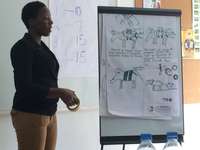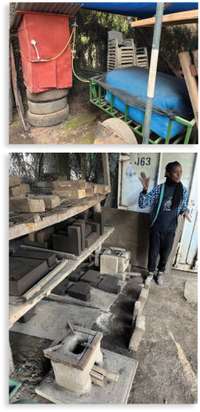Build It and They Will Come” is a common expression in the American business world. It is NOT a model for achieving the adoption of new practices to improve productivity in the world of traditional agriculture.
Yes, it is necessary to improve “inputs” that increase short and long-term productivity. We must develop appropriate technologies, identify cultural practices that maintain and improve soil conditions, and provide plants and seeds appropriate for our target areas and farmers. But these efforts are not sufficient to achieve success.
To bring about meaningful change it is essential that the change agency/agents also have an understanding of the factors and practices to consider and apply in achieving adoption, and diffusion, among the target communities and individual farmers.
What are those factors?
Research on Adoption

Figure 1. Presentations of problems expressed by community members during a creative capacity building workshop. Source: Stacy Swartz
Substantial research and professional writing give us important insights, especially in rural sociology and social psychology. Some sources will be highlighted here.
Hybrid corn was developed in the U.S. in the early 1900s, but it was still a topic of debate for adoption in the 1930s-early 40s. Can we trust hybrids as a replacement for open-pollinated corn? Why should we buy this expensive seed when I can just use my seed corn from last year’s field? Eugene Wilkening, a renowned rural sociologist at the University of Wisconsin, was among the leaders who did significant research in the adoption of hybrid corn and other innovations.
His studies looked at those farmers who adopted and those who resisted. He classified target groups, and characterized them in a range from “innovators/early adopters” to “late adopters/resisters”. He emphasized the important role of early adopter farmers as models and enablers to encourage change in practices among those who resisted. His research provides important guidelines for change agents working in the field.
Research within social psychology is also relevant. During WWII there was a shortage of meat for the American consumer. With funding from the U.S. government, researchers conducted group meetings to encourage the use of animal parts not normally considered for cooking and consumption. Presentations were made to housewives, divided into two groups, “A” and “B”. Both were given the same lecture and slide presentation. However, at the end of the presentation to group “B” they were asked “How many of you are willing to try these animal meat parts? Please raise your hand.” Adoption among the “B” group was significantly higher than group “A”.
Change Agent Plan and Application In the Field

Figure 2. Two different technologies ECHO East Africa has been promoting and obtaining feedback on for multiple years: biogas storage options for commercialization (top) and rocket stoves (bottom). Source: Rod Sebastian
In summary, adoption and diffusion is more successful by identifying those in a community who are “innovators”, and asking participants in a group presentation to make a visible public commitment among one’s peers. Abundant evidence shows these practices greatly increase the chances of follow-through on implementing the innovation. In many cultures, this often also requires contact and acceptance among tribal leaders.
Other relevant research has investigated the roles, timelines, and effectiveness of various sources of information about innovative practices. The caution here, and a major qualification of this article, is transferring “Western” findings to developing country environments with significant cultural differences. However, what is common among all situations is the reality that any innovative adoption requires effective communication about that new practice. Chances of adoption increase if awareness of a new practice/innovation can come prior to the introduction of the practice in the field, that awareness can be communicated directly but also effectively through a variety of third-party sources (i.e., mass communication). In today’s world that may even include the cell phone!
Patience and persistent follow-up are often required from the time of awareness to the adoption and diffusion of the innovation. Many studies show up to seven years between introduction and adoption! Another factor affecting timelines with tribal groups relates to gender roles. For example, women attending information sessions on innovation will likely have minimum power in the decision to adopt the new household or farm practice. And the reality is that most group meetings are dominated by women. A fairly recent study in Nigeria focused on the importance of finding ways of empowering women as a consideration for adoption. In any case, bringing the males into the follow-up presentations and conversation is essential.
Finally, these facts about adoption, especially timelines, are modified by the obvious differences that exist between a straight-forward innovation (i.e rocket stoves for cooking) and a more complex cultural practice (i.e. intercropping, controlling erosion, etc,) Regardless of complexity, however, the change agent/agency must give attention to a program plan and strategies for introducing the innovation.
In summary, “build it” AND “introduce it” with a good plan and strategy. Good luck.